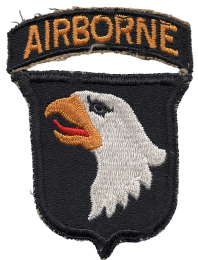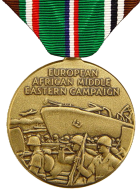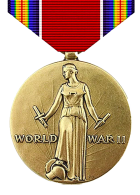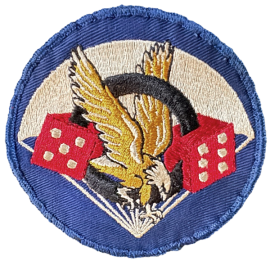All the time we were in England, it was obvious that our training was geared to prepare us for 'The Invasion". In late May, we packed up to move to the marshaling area for the D-Day jump. The marshaling area was down near Exeter in southern England. We arrived there on a Sunday about a week before D-Day. The briefing started the day after our arrival. In our area, the battalionlevel got the information first, then the commanders, then the companycommanders informed the platoon leaders and the NCO's (non commissioned officers). My first view of everything was with the company commander, the platoon leaders and the NCO's ui the long, narrow briefing tent. This tent was about 100 feet long, eight feet wide and 10 feet high. Inside were sand tables with miniature buildings and vegetation which modeled the terrain of the area, along with maps, air photos and schematic drawings ofthe place. Throughout the week we would visit the briefing area with our squadsand were given time to familiarize ourselves with the entire mission. It was then that we formulated our plans as to how our squad would complete its particularpart of the picture. We knew at this time where we were going and what we were going to do. We did not know at this time when we were going.
The final plan was known as "Operation Overlord" and called for landings by the American First Army and the British Second Army on five beaches, each approximately 3 miles in length, along some sixty miles of the coast off Normandy, France. These landings were scheduled to take place a dawn. Preceding them by several hours would be landings by airborne troops, including troops from my division, the 101st Airborne. The scale of Operation Overlord was immense. Nearly 200.000 men would assault the German's highly touted "Atlantic Wall" within the space of 48hours. When all was said and done, an army of two million men would pour into France across the Normandy beachhead. Eisenhower had made the final decision that the invasion would happen on June 6, 1944, D-Day.
June 5, 1944
On Monday afternoon, June 5th, it was our Company's time to go up and take showers. When we came back from the showers about 4:00 p.m., we were told we would go that night I remember we had ice cream for chow at the evening meal. It was partially frozen in metal cam, but this was a rare treat. I will tell you, however, I wasn't particularly thinking about ice cream and I don't think anyone else was either
We were about to play our part in the largest airborne operation everattempted: 925 planes carrying 13.000 men from the US, 101st and 82d Airborne Divisions, flying to six drop zones all within a few miles of the town of Ste- Mere-Eglise and the Utah Beach invasion area. We were due to take-off at around 11:00 pm. We were spending our time getting everything ready. Our chutes were already on the plane and we were blackening our faces with smut. When it was time to go, we got our chutes out of the plane and put everything on, ready to move out. Word came to get aboard the planes, but we had so much stuff on that in order to get inside, a man behind you had to push you up and a man in front of you had to pull you in back then. I weighed about 175-180 pounds stripped. With all the chutes and equipment I had on at the time, I topped out at about 300 pounds. Our machinegun ammo weighed a lot and I Jumped with an extra box of it.
On board, I remember looking at my watch It was 11:07 p m and it was just getting good and dark. It took quite a while for the planes to assemble and get ready to string out in formations On my plane, in our stick, were seventeen men Lieutenant Semon, our platoon leader, was the first man. Haney, the youngest, was the number two man. Machine gunner Waters was number three. I forget the exact order all the way back except that I was next to last, and Borden was last The other men in the stick were Grodowski, (the guy with thePolish RAF cousin), Robbins, Passino. Hogenmiller, Ochoa, Tom, Tumble. Gillispie, Cauvin, Provenzano and a medic, whose name I do not remember.
The Crossing of the Channel
The guys on the plane seemed fairly relaxed going over Most of us tookone motion sickness pill about an hour before we took off, and another one justbefore takeoff I know I had butterflies, but I had made up my mind at thebeginning that if I had any doubts about not Jumping, it was going to be before (One guy that finished parachute school with me refused to jump again. He just didn' thave the nerves for it. I admired him for admitting his phobias then, instead of jeopardizing us in combat later on) I got on the plane, once I got on the plane, I was there and the commitment was made and I could pretty welt settle down to whatever we would hit.
On the way over, I could not see any outward anxieties or displays ofemotions that were contrary to what I would call normal. In fact, because we'dtaken motion sickness medicine, there was some dozing during the trip. I know Islept a little bit, until I was told we were coming up on the coast of France. It took a little over two hours to get to our destination. We did not fly inthe most direct route over Utah Beach. Instead we flew around the tip of the Cherbourg Peninsula and came in around "the back side". As we approached the coast of France, we could see tracers and quite a bit of fire power coming upin the sky. We were flying at approximately 700 to 800 feet, or were supposedto be at any rate. I assumed we were pretty close to it.
Our planes probably climbed to about 1.500 feet just before they dropped us. After I was dropped and saw that I was about to land over water, I did everything I could to steer my parachute clear of the water. I had over a hundred extra pounds of equipment on me and, having lost my knife on the jump, I had no way of cutting it off. I thought I was about to die.
Throughout the duration of the war I experienced several major "strokes of good fortune." My first one was about to happen. I did miss that water. I landed on a narrow piece of land barely 25 feet from it. I later found out that twoothers in our stick were not so fortunate. Lieutenant Semon, the first man out,landed in deep water and drowned. Robbins tried to revive him, but he wasalready dead. "Rebel" Waters, the third man out , carried the machine guntripod and ammunition. He too landed in the water and drowned with all hisequipment in a field flooded by the Germans.
Borden, the last man out, landed in the water, but he got out all right.Haney, the young machine gunner, was the #2 man out. When he saw that hewas headed toward the same deep water that killed the guy before him, he cuthis gun and other equipment off. Instead of hitting the water, however, helanded on a narrow, dry strip of railroad tracks that ran through the middle of theflooded area. The other men missed the water. I can't remember exactly how thegroups got together after they landed. I believe Haney was solo for the rest ofthe night. I joined up with him early the next morning.
Clearing a Path on The "Highway to Hell"
By September 1944, the Allies' principal objectives in France had been accomplished. The main German army for the most part was in retreat, heading full speed north through Germany to protect its northern borders. This area was vulnerable to Allied invasion geographically because its relatively flat terrain was suitable for tanks to cross and head east to Berlin. The Allies next objective therefore, was to beat the Germans there and outflank them to the north. To accomplish this objective, the Allies needed a clear path from France, north through Holland, (which borders the western side of Germany and which atthat time was in German hands). Once that was secured, the plan was for the British Second Army to blast its way through Holland and invade Germany heading east.
It was decided that a path would be cleared on the Dutch highway starting at the city of Eindhoven, and extending 54 miles north to the city ofAmhem. Amhem was close to the flat, northern plains of Germany, and was viewed as a good jumping off point for the Allies to move east to Berlin. As you can see from the rough map to your right (in the green bar), in order to get to Arnhem from Eindhoven on this highway, the British Second Army would have to cross a series of rivers which were spanned by highway bridges.
German destruction of these bridges would bottleneck the advance andhad to be prevented. Allied control of these crosspoints, therefore, was critical. That was the job of the paratroopers, and required the launch of the largest airborne operation in history. Although the official code name for this plan was "Operation Market-Garden", because of the tremendous difficulties experienced by the Allies inaccomplishing these goals, the Eindhoven to Arnhem stretch became betterknown as the "Highway to Hell".
Mission of the 101st Airborne Division, How Fighting Units are Organized
The first objective of the 101st was to get control of the bridges at Son, (pronounced "Zon"), St. Oedenrode and Veghel. In order to help the reader understand how the action took place, it is helpful to know how fighting units were basically organized.
Squads have about 12 men. A Platoon may be composed of 3 or 4squads for a total of up to 46 men.
Company is composed of three platoonsor approximately 144 men.
Battalion consists of 3 Companies, plus a Headquarters Company (containing communications, demolition, and medicalsupport teams) or approximately 600 men.
Regiment is made up of 3 Battalions plus a Regimental Headquarters Company, or approximately 1900 men.
Division consists of 3 Parachute Regiments, 1 Glider Regiment, 1 Engineer Battalion, 1 Parachute Artillery Battalion, 2 Glider Artillery Battalions ,and a Divisional Headquarters Company containing among other things, the top intelligence personnel and special forces. The 101st Airborne Division had 3 Parachute Regiments the 501, the502 and my regiment, the 506th. Thus I was Squad Leader of Squad 1, Second Platoon, Fox Company, Second Battalion, 506th Regiment of the 101st division of the American 1st Army of the Allied Forces!
September 17, 1944
My regiment, the 506th, was to be dropped near the town of Son. Our particular task was to secure the Wilhelmina Canal bridge there, then drive on south, take the City of Eindhoven (population 110.000) and connect up with the British Second Army which was to be moving up from the south. We got up on Sunday morning, September 17th, and were ready to go. It was a nice, clear day and we took off from England at around 11:00 a.m. The mission had a different atmosphere to it than did our Normandy drop. For one thing it was a daylight operation. There seemed to be a relaxed feeling about the trip withinour stick.
When we flew out, I remember seeing the famous white cliffs of Dover forthe first time as I stood in the door of the plane and looked back at the English coast. We went in over northern France, then northward over Belgium. You could see plenty of bomb craters over the countryside.
The flight was uneventful until we reached the British front lines. Even then we did not draw too much fire going in. A couple of tracer bullets went through our wing. Just before we jumped. We nevertheless hit our drop zone target near Son, which left us about six or seven miles north of Eindhoven. The DZ was in good, open terrain and the drop was very routine. In F Company we had only one casualty, a man broke his arm on the drop.
There was not much fire in the drop zone because the Germans had nofdea where we were going to drop. There were so many planes in the air thatday, it was difficult for them to know just where everybody was going to be anyway. Within an hour, Second Battalion was on the main road going into Son, which was a rather small town. The friendly Dutch people swarmed out along the side of this road, and as we moved into Son, they would hand us something to drink. I believe D Company was leading the way. I could see the bridge fromiy position in the F Company ranks. Just as D Company was about to reachie bridge, all of sudden it blew up!
In my mind's eye, I can still see the debris going up in the air. The leaders told us there were some Germans down in the nearby church and my squad was ordered run over there and flush them out. We went all around and through it and couldn't find anybody. In any event, our progress was certainly held up with the bridge being out of commission. It took us about two hours to worm our way across by stepping on the debris of the exploded bridge. By that afternoon, we were all on the other side.
We moved on down the road about a mile or two, and decided that night to wait until morning to take Eindhoven. At 9:00 a.m. we started moving against pretty heavy artillery fire coming from the town. All of a sudden, Second platoon was ordered to move on the double to the left flank as we approached edge of the city. Lieutenant Hall was our platoon leader and Lieutenant Perdue was assistant platoon leader. We moved fast through the industrial district past factories and manufacturing plants. I remember seeing the Philips Industry plant.
Good Fortune Strikes Again, The Lady in the Upstairs Window
I didn't know why we'd been rushed over to the left until we reached the residential section. There, Captain Shuttle, a Battalion Staff Officer, told us we needed to take out a German gun position that was firing on the column. A Dutch civilian (This civilian's name was ''Bert Pulles". He and his wife, who is the famous "lady in the window" you'll read about below, have been welcome guests at reunions of the 101st Airborne.) led us to a street comer and pointed out the location of this nest which was about a block or two away. Lieutenant Hall took the first squad, twelve men and Sergeant Borden and we started moving in that directionthrough back yards and between houses. Of course, the gun fired a couple of times and we knew we were getting dose.
We came up behind a row of houses and Lieutenant Hail told us to stop there for a minute. I was with Grodowski and two of the new men, Sherwood and Shrout when we held up between two houses about four feet across. At the end of these houses, was a wooden gate about head high that opened out onthe street. The gate was set off the ground so that you could see under it.
I was just about to open the gate and go out, when something caught myeye and 1 stopped. I could see a lady in an upstairs window across the streetwaiving her arms, I later found out that this nice Dutch woman was named "Coby Pulles". I met her again over 40 years later at a 101st Airborne Reunion. I didn't know what it was about, but I held back a second. Just as I hesitated, I saw the boots of two German soldiers pass by under this gate!
We jumped out into the street after them and, I guarantee those were two surprised Krauts! They acted like they didn't even know the Americans were anywhere around. We grabbed them and pulled them inside the gate. We took away their weapons and sent someone to take them back with the other prisoners of war. We then continued in our search for the German artillery nest. We went back out into the street looking left in the direction where we thought the big gun was. The road curved just enough so we could not see the end of it. We had to advance further and saw that the road dead-ended into another street.
It was there that I saw what we were looking for a big German 88mm machine gun the kind that can shoot down aircraft. It was set up on a large platform about 100 yards down from the where I was. I could see that the Germans saw me. Sherwood was with me and the Germans were cranking the gun down to where it could fire at us. At that point I just stopped right in the middle of the road and fired everything I had a whole clip at the gun crew. I wounded two of them.
John H. Taylor









